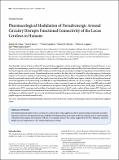Pharmacological Modulation of Noradrenergic Arousal Circuitry Disrupts Functional Connectivity of the Locus Ceruleus in Humans
Author(s)
Kucyi, Aaron; Napadow, Vitaly; Loggia, Marco L.; Akeju, Oluwaseun; Song, Andrew H.; Brown, Emery Neal; ... Show more Show less
Download6938.full.pdf (1.276Mb)
PUBLISHER_CC
Publisher with Creative Commons License
Creative Commons Attribution
Terms of use
Metadata
Show full item recordAbstract
State-dependent activity of locus ceruleus (LC) neurons has long suggested a role for noradrenergic modulation of arousal. However, in vivo insights into noradrenergic arousal circuitry have been constrained by the fundamental inaccessibility of the human brain for invasive studies. Functional magnetic resonance imaging (fMRI) studies performed during site-specific pharmacological manipulations of arousal levels may be used to study brain arousal circuitry. Dexmedetomidine is an anesthetic that alters the level of arousal by selectively targeting α2 adrenergic receptors on LC neurons, resulting in reduced firing rate and norepinephrine release. Thus, we hypothesized that dexmedetomidine-induced altered arousal would manifest with reduced functional connectivity between the LC and key brain regions involved in the regulation of arousal. To test this hypothesis, we acquired resting-state fMRI data in right-handed healthy volunteers 18–36 years of age (n = 15, 6 males) at baseline, during dexmedetomidine-induced altered arousal, and recovery states. As previously reported, seed-based resting-state fMRI analyses revealed that the LC was functionally connected to a broad network of regions including the reticular formation, basal ganglia, thalamus, posterior cingulate cortex (PCC), precuneus, and cerebellum. Functional connectivity of the LC to only a subset of these regions (PCC, thalamus, and caudate nucleus) covaried with the level of arousal. Functional connectivity of the PCC to the ventral tegmental area/pontine reticular formation and thalamus, in addition to the LC, also covaried with the level of arousal. We propose a framework in which the LC, PCC, thalamus, and basal ganglia comprise a functional arousal circuitry.
Date issued
2017-07Department
Harvard University--MIT Division of Health Sciences and Technology; Massachusetts Institute of Technology. Department of Electrical Engineering and Computer ScienceJournal
Journal of Neuroscience
Publisher
Society for Neuroscience
Citation
Song, Andrew H. et al. “Pharmacological Modulation of Noradrenergic Arousal Circuitry Disrupts Functional Connectivity of the Locus Ceruleus in Humans.” The Journal of Neuroscience 37, 29 (June 2017): 6938–6945 © The Authors
Version: Final published version
ISSN
0270-6474
1529-2401